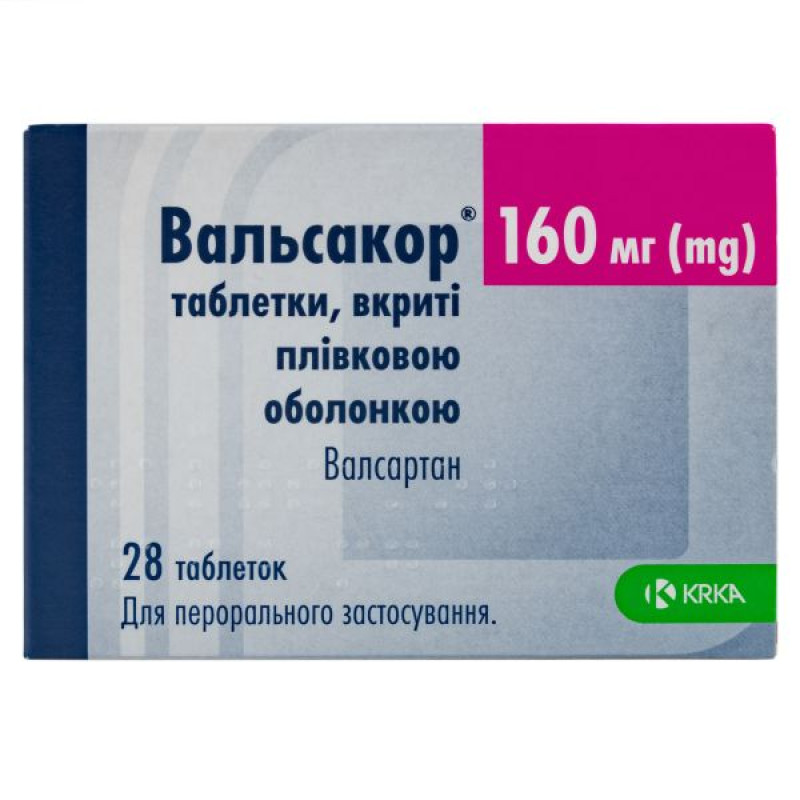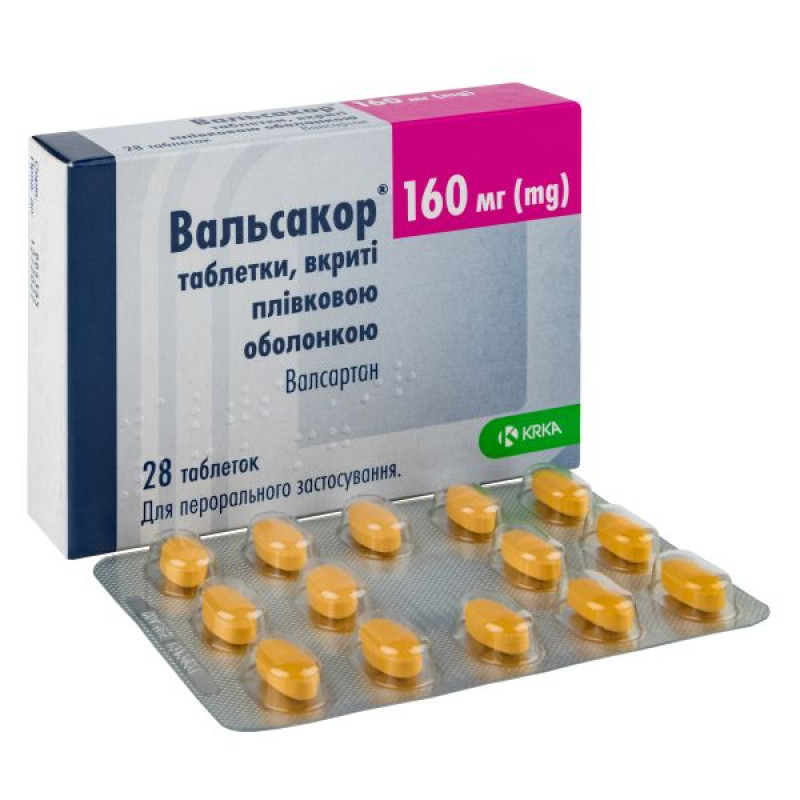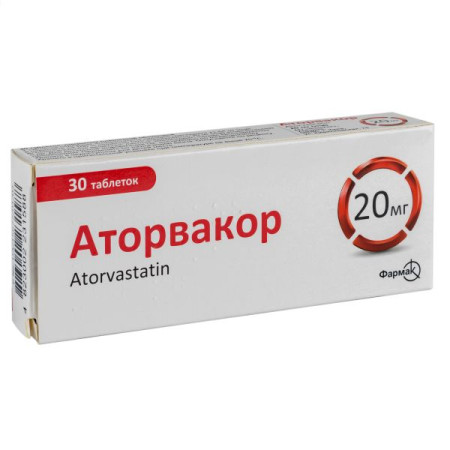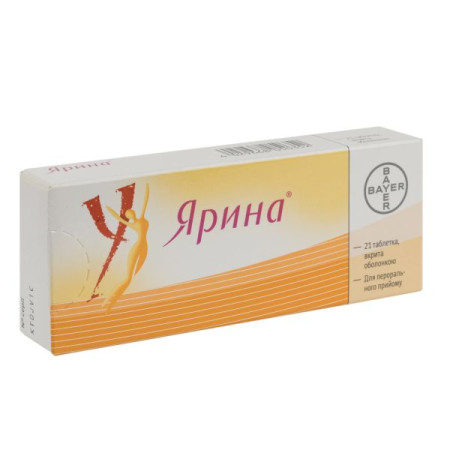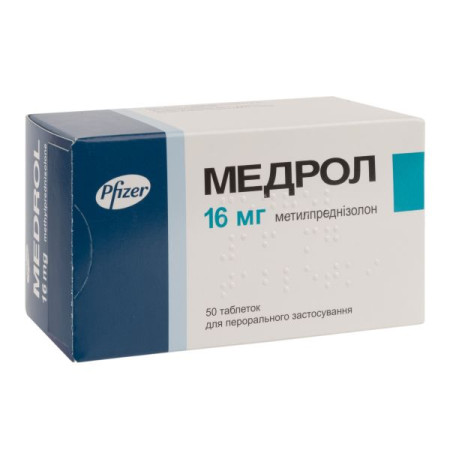Valsakor film-coated tablets 160 mg No. 28

Instructions for Valsakor film-coated tablets 160 mg No. 28
Composition
active ingredient: 1 film-coated tablet contains 40 mg or 80 mg, or 160 mg, or 320 mg of valsartan;
excipients: lactose monohydrate, microcrystalline cellulose, povidone, croscarmellose sodium, colloidal anhydrous silica, magnesium stearate, hypromellose, titanium dioxide (E 171), macrogol 4000, yellow iron oxide (E 172) - available in film-coated tablets of 40 mg, 160 mg and 320 mg, red iron oxide (E 172) - available in film-coated tablets of 80 mg, 160 mg and 320 mg.
Dosage form
Film-coated tablets.
Main physicochemical properties:
40 mg tablets: yellow-brown, round, slightly biconvex, film-coated tablets, with a score on one side;
80 mg tablets: pink, round, biconvex, film-coated tablets, scored on one side;
160 mg tablets: yellow-brown, oval, biconvex, film-coated tablets, scored on one side;
320 mg tablets: light brown, capsule-shaped, biconvex, film-coated tablets, scored on one side.
Pharmacotherapeutic group
Simple angiotensin II antagonist drugs.
ATX code C09C A03.
Pharmacological properties
Pharmacodynamics
Valsartan is a potent, specific angiotensin II receptor antagonist. It acts selectively on the AT1 receptor subtype, which is responsible for the known effects of angiotensin II. Increased plasma levels of angiotensin II following blockade of AT1 receptors by valsartan may stimulate unblocked AT2 receptors, which regulate the action of AT1 receptors. Valsartan does not exhibit any agonist activity at AT1 receptors and has a much higher affinity (approximately 20,000-fold) for AT1 receptors than for AT2 receptors. It is not known whether valsartan binds to or blocks other hormone receptors or ion channels important for cardiovascular regulation.
Valsartan does not inhibit the activity of ACE (also known as kininase II), which converts angiotensin I to angiotensin II and catalyzes the breakdown of bradykinin. Angiotensin II antagonists do not cause cough because they do not affect the activity of angiotensin-converting enzyme and do not increase the production of bradykinin and substance P.
Treatment of patients with hypertension with valsartan resulted in a decrease in blood pressure without affecting heart rate.
In most patients, the hypotensive effect develops within 2 hours after a single oral dose, and the maximum effect on blood pressure is achieved within 4-6 hours. The hypotensive effect lasts for more than 24 hours after taking the dose. With repeated use, the maximum reduction in blood pressure is achieved after 4 weeks and is maintained throughout the entire period of long-term treatment. When used simultaneously with hydrochlorothiazide, an additional reduction in blood pressure is achieved.
Abrupt discontinuation of valsartan does not lead to a sudden increase in blood pressure and other adverse clinical events in patients.
With long-term use in patients with arterial hypertension, it was found that the drug had no significant effect on the level of total cholesterol, uric acid, and in fasting studies - on the concentration of triglycerides and glucose in blood serum.
The use of the drug leads to a decrease in hospitalizations for heart failure, a slowdown in the progression of heart failure, an improvement in the functional class according to the NYHA classification, an increase in the ejection fraction, as well as a decrease in the signs and symptoms of heart failure and an improvement in the quality of life compared to placebo.
Valsartan was also effective in reducing cardiovascular mortality and hospitalizations for heart failure, as well as recurrent myocardial infarction. Valsartan had a positive effect on the time from acute myocardial infarction to the first signs of cardiovascular disease leading to death.
Two large randomized controlled trials (ONTARGET (ONgoing Telmisartan Alone and in combination with Ramipril Global Endpoint Trial) and VA NEPHRON-D (The Veterans Affairs Nephropathy in Diabetes)) investigated the use of a combination of ACE inhibitors with angiotensin II receptor blockers.
ONTARGET was a study conducted in patients with a history of cardiovascular or cerebrovascular disease or type 2 diabetes mellitus with evidence of end-organ damage. VA NEPHRON-D was a study in patients with type 2 diabetes mellitus and diabetic nephropathy.
These studies did not show a significant beneficial effect on renal and/or cardiovascular outcomes and mortality, although there was an increased risk of hyperkalemia, acute kidney injury, and/or hypotension compared with monotherapy. Given their similar pharmacodynamic properties, these findings also apply to other ACE inhibitors and angiotensin II receptor blockers.
ALTITUDE (Aliskiren Trial in Type 2 Diabetes Using Cardiovascular and Renal Disease Endpoints) was a study designed to test the benefits of adding aliskiren to standard therapy with an ACE inhibitor or an angiotensin II receptor blocker in patients with type 2 diabetes and chronic kidney disease, cardiovascular disease, or both. The study was stopped early due to an increased risk of adverse outcomes. Cardiovascular events and stroke were more common in the aliskiren group than in the placebo group, and adverse events and serious adverse events of interest (hyperkalemia, hypotension, and renal dysfunction) were more frequently reported in the aliskiren group than in the placebo group.
Children
The antihypertensive effect of valsartan was evaluated in 4 randomized, double-blind clinical trials in 561 children aged 6 to 18 years and in 165 children aged 1 to 6 years. Renal and urinary disorders and obesity were the most common underlying medical conditions causing hypertension in children included in these trials.
Clinical experience in children aged 6 years and over
In a clinical study involving 261 children with hypertension aged 6 to 16 years, patients weighing < 35 kg received 10, 40 or 80 mg of valsartan per day (low, medium and high doses), patients weighing ≥ 35 kg received 20, 80 and 160 mg of valsartan per day (low, medium and high doses). At the end of 2 weeks, valsartan reduced systolic and diastolic blood pressure in a dose-dependent manner. Overall, the three valsartan dose levels (low, medium and high) significantly reduced systolic blood pressure by 8, 10, 12 mm Hg from baseline, respectively.
In a second clinical trial involving 300 pediatric patients aged 6 to 18 years with hypertension, patients were randomized to receive valsartan or enalapril tablets for 12 weeks. Children weighing ≥18 kg to <35 kg received valsartan 80 mg or enalapril 10 mg; those weighing ≥35 kg to <80 kg received valsartan 160 mg or enalapril 20 mg; those weighing ≥80 kg received valsartan 320 mg or enalapril 40 mg. The reduction in systolic blood pressure was comparable in patients receiving valsartan (15 mmHg) and enalapril (14 mmHg) (p level <0.0001). Consistent results were observed for diastolic blood pressure with reductions of 9.1 mmHg and 8.5 mmHg with valsartan and enalapril, respectively.
In a third open-label clinical study in 150 children aged 6 to 17 years with hypertension, eligible patients (systolic BP ≥95th percentile for age, sex, and height) received valsartan for 18 months to evaluate safety and tolerability. Of the 150 patients enrolled in this study, 41 patients were also receiving concomitant antihypertensive therapy. Patients were assigned initial and maintenance doses according to their weight categories. Patients weighing >18 to <35 kg, ≥35 to <80 kg, and ≥80 to <160 kg received 40 mg, 80 mg, and 160 mg, and the doses were titrated to 80 mg, 160 mg, and 320 mg, respectively, after one week. Half of the enrolled patients (50.0%, n=75) had CKD, with 29.3% (44) of the patients having stage 2 (GFR 60–89 mL/min/1.73 m2) or stage 3 (GFR 30–59 mL/min/1.73 m2) CKD. The mean reduction in systolic blood pressure was 14.9 mmHg in all patients (baseline 133.5 mmHg), 18.4 mmHg in patients with CKD (baseline 131.9 mmHg), and 11.5 mmHg in patients without CKD (baseline 135.1 mmHg). The percentage of patients achieving overall BP control (both systolic and diastolic BP <95th percentile) was slightly higher in the CKD group (79.5%) compared with the non-CKD group (72.2%).
Pharmacokinetics
Absorption
After oral administration of the drug, peak plasma concentrations of valsartan are reached in 2-4 hours, in the form of a solution - in 1-2 hours. The average absolute bioavailability of tablets and solution of the drug is 23% and 39%, respectively. Food intake reduces exposure to valsartan by approximately 40% and peak plasma concentrations by approximately 50%, although approximately 8 hours after administration, plasma concentrations of valsartan are similar in the fasted and fed states. However, this decrease in exposure is not accompanied by a clinically significant decrease in the therapeutic effect, and therefore valsartan can be used either with or without food.
Distribution
The volume of distribution of valsartan at steady state after intravenous administration is approximately 17 L, indicating that valsartan is not extensively distributed into tissues. Valsartan is highly bound to serum proteins (94-97%), primarily albumin.
Biotransformation
Valsartan is not extensively biotransformed, with only about 20% of the dose recovered as metabolites. A hydroxymetabolite has been identified in plasma at low concentrations (less than 10% of the AUC of valsartan). This metabolite is pharmacologically inactive.
Valsartan shows multiexponential decay kinetics (t1/2a<1 hour and t1/2β approximately 9 hours). Valsartan is mainly excreted via the biliary tract in the feces (about 83% of the dose) and via the kidneys in the urine (about 13% of the dose), mostly unchanged. After intravenous administration, the plasma clearance of valsartan is approximately 2 l/hour, and its renal clearance is 0.62 l/hour (about 30% of the total clearance). The half-life of valsartan is 6 hours.
Patients with heart failure (40 mg, 80 mg and 160 mg only)
The mean time to peak concentration and the half-life of valsartan in patients with heart failure and healthy volunteers are the same. The values of the area under the concentration-time curve (AUC) and the maximum concentration of valsartan increase linearly and almost proportionally with increasing dose above the clinical range (40-160 mg 2 times a day). The accumulation coefficient is on average 1.7. The clearance of valsartan after oral administration is approximately 4.5 l / h. Age does not affect the clearance of the drug in patients with heart failure.
Certain patient groups
Elderly patients
In some elderly patients, the systemic exposure to valsartan was somewhat greater than in younger patients; however, this has not been shown to be of any clinical significance.
Patients with renal impairment
No correlation was found between renal function and systemic exposure to valsartan. Therefore, no dose adjustment is required in patients with impaired renal function (creatinine clearance > 10 ml/min). There is currently no experience with the safety of the drug in patients with creatinine clearance < 10 ml/min or in patients undergoing dialysis, so valsartan should be used with caution in such patients. Valsartan is highly bound to plasma proteins and is unlikely to be removed by hemodialysis.
Patients with impaired liver function
Approximately 70% of the absorbed dose is excreted in the bile, mainly unchanged. Valsartan is not significantly metabolized, and as expected, the systemic exposure to valsartan does not correlate with the degree of hepatic impairment. Therefore, no dose adjustment of valsartan is required in patients with non-biliary hepatic insufficiency and in the absence of cholestasis. It has been shown that the AUC of valsartan increases approximately twofold in patients with biliary cirrhosis or biliary obstruction.
Children with renal impairment
The use of the drug in children with creatinine clearance < 30 ml/min and in children undergoing dialysis has not been studied, therefore valsartan is not recommended in such patients. For children with creatinine clearance > 30 ml/min, no dose adjustment is necessary. Renal function and serum potassium should be closely monitored.
Indication
Arterial hypertension (80 mg, 160 mg and 320 mg tablets).
Treatment of arterial hypertension in adults and children aged 6 to 18 years.
Arterial hypertension (40 mg tablets).
Treatment of arterial hypertension in children aged 6 to 18 years.
Post-infarction condition (tablets 40 mg, 80 mg and 160 mg).
Treatment of clinically stable adult patients with symptomatic heart failure or asymptomatic left ventricular systolic dysfunction following a recent (12 hours - 10 days) myocardial infarction.
Heart failure (40 mg, 80 mg and 160 mg tablets).
Treatment of adult patients with symptomatic heart failure when angiotensin-converting enzyme (ACE) inhibitors are not tolerated or in patients who are intolerant to beta-blockers as an adjunct to ACE inhibitor therapy when mineralocorticoid receptor antagonists cannot be used (see sections "Pharmacodynamics", "Interaction with other medicinal products and other types of interactions", "Special instructions for use", "Method and dosage").
Contraindication
Hypersensitivity to the active substance or to any of the components of the drug; severe liver dysfunction, biliary cirrhosis and cholestasis; pregnant women or women planning to become pregnant (see "Use during pregnancy and breastfeeding"); simultaneous use of angiotensin receptor antagonists, including valsartan, or angiotensin-converting enzyme inhibitors with aliskiren in patients with diabetes mellitus or renal impairment (glomerular filtration rate GFR <60 ml/min/1.73 m2).
Interaction with other medicinal products and other types of interactions
Dual blockade of the renin-angiotensin system (RAS) with ARA, ACE inhibitors or aliskiren
Clinical trial data have shown that dual blockade of the renin-angiotensin-aldosterone system (RAAS) through the combined use of ACE inhibitors, angiotensin II receptor blockers or aliskiren is associated with a higher incidence of adverse events such as hypotension, hyperkalemia and decreased renal function (including acute renal failure) compared with the use of a single RAAS-acting agent (see sections 5.1, 5.2 and 5.3).
Concomitant use is not recommended.
Reversible increases in serum lithium concentrations and toxicity have been reported during concomitant administration of ACE inhibitors or angiotensin II receptor antagonists, including valsartan, with lithium. If the combination proves necessary, careful monitoring of serum lithium levels is recommended. The risk of lithium toxicity may be further increased if a diuretic is also used.
Potassium
Potassium-sparing diuretics (e.g. spironolactone, triamterene, amiloride), potassium supplements, salt substitutes containing potassium and other medicinal products that may increase potassium levels (heparin, etc.) may lead to increases in serum potassium and, in patients with heart failure, to increases in creatinine levels.
If it is necessary to use a medicinal product that affects potassium levels in combination with valsartan, monitoring of potassium levels in the blood plasma is recommended.
Precautions for concomitant use
Nonsteroidal anti-inflammatory drugs (NSAIDs), including selective COX-2 inhibitors, acetylsalicylic acid > 3 g/day), and nonselective NSAIDs
When angiotensin II antagonists are administered concomitantly with NSAIDs, attenuation of the antihypertensive effect may occur. Furthermore, concomitant administration of angiotensin II antagonists and NSAIDs may lead to deterioration of renal function and an increase in serum potassium. Therefore, monitoring of renal function at the beginning of treatment and adequate fluid intake are recommended.
Conveyors
In vitro studies have shown that valsartan is a substrate for the hepatic uptake transporter OATP1B1/OATP1B3 and the hepatic efflux transporter MRP2. The clinical significance of these findings is unknown. Concomitant use of inhibitors of the OATP1B1 transporter (e.g. rifampicin, cyclosporine) or MRP2 transporter (e.g. ritonavir) may increase systemic exposure to valsartan. Appropriate precautions should be taken when initiating or discontinuing concomitant use of these medicinal products.
Others
No interactions of valsartan with any of the following substances were found: cimetidine, warfarin, furosemide, digoxin, atenolol, indomethacin, hydrochlorothiazide, amlodipine, glibenclamide.
Children
Caution is recommended when valsartan is used concomitantly in children with hypertension with other substances that inhibit the renin-angiotensin-aldosterone system, which may increase serum potassium levels.
Application features
Hyperkalemia
Concomitant use with potassium supplements, potassium-sparing diuretics, salt substitutes containing potassium, or other drugs that may increase potassium levels (heparin, etc.) is not recommended. Potassium levels should be monitored as necessary.
Kidney dysfunction
No dose adjustment is necessary in patients with renal impairment (creatinine clearance > 10 ml/min). There is currently no experience of safe use in patients with creatinine clearance < 10 ml/min or in patients undergoing dialysis, therefore valsartan should be used with caution in such patients.
Liver dysfunction
Valsartan should be administered with caution to patients with mild to moderate hepatic impairment without cholestasis.
Patients with sodium and/or volume imbalance
In patients with severe sodium and volume imbalance (e.g. those receiving high doses of diuretics), symptomatic hypotension may occur in isolated cases after initiation of valsartan therapy. Sodium and/or volume imbalance should be corrected before initiation of valsartan therapy, e.g. by reducing the dose of the diuretic.
Renal artery stenosis
The safety of valsartan has not been established in patients with bilateral renal artery stenosis or stenosis of the artery to a solitary kidney. Short-term administration of valsartan to patients with vasorenal hypertension secondary to unilateral renal artery stenosis did not cause any significant changes in renal hemodynamic parameters, serum creatinine, or blood urea nitrogen. Since other drugs that affect the renin-angiotensin-aldosterone system (RAAS) may increase blood urea and serum creatinine in patients with unilateral renal artery stenosis, monitoring of renal function is recommended as a safety measure during treatment with valsartan.
Kidney transplantation
There is currently no experience with the safe use of valsartan in patients who have recently undergone kidney transplantation.
Primary hyperaldosteronism
Patients with primary hyperaldosteronism should not use valsartan because they do not have an activated renin-angiotensin system.
Aortic and mitral valve stenosis, obstructive hypertrophic cardiomyopathy
As with other vasodilators, the drug should be administered with extreme caution to patients with aortic or mitral valve stenosis or obstructive hypertrophic cardiomyopathy.
Angiotensin II receptor antagonists are contraindicated during pregnancy. Unless continued therapy is considered essential, patients planning pregnancy should be changed to alternative antihypertensive treatments which have an established safety profile for use in pregnancy. When pregnancy is diagnosed, treatment should be stopped immediately, and, if appropriate, alternative therapy should be started.
Recent myocardial infarction (40 mg, 80 mg and 160 mg only)
The combination of captopril and valsartan did not show any additional clinical benefit, but the risk of adverse reactions increased compared to treatment with the respective drugs. Therefore, the combination of valsartan and an ACE inhibitor is not recommended.
Caution should be exercised when initiating therapy in patients with a history of myocardial infarction. Renal function should be included in the evaluation of patients after myocardial infarction. Administration of valsartan to patients after myocardial infarction often results in some reduction in blood pressure, but discontinuation of therapy due to persistent symptomatic hypotension is usually not necessary provided the dosage instructions provided are followed.
Heart failure (40 mg, 80 mg and 160 mg only)
The risk of adverse reactions, especially hypotension, hyperkalemia and decreased renal function (including acute renal failure), may be increased when valsartan is used in combination with an ACE inhibitor. In patients with heart failure, the triple combination of an ACE inhibitor, a β-blocker and valsartan has not shown any clinical benefit. This combination is likely to increase the risk of adverse events and is therefore not recommended. The triple combination of an ACE inhibitor, a mineralocorticoid receptor antagonist and valsartan is also not recommended. The use of these combinations should be under specialist supervision and with frequent and careful monitoring of renal function, electrolytes and blood pressure.
Caution should be exercised when initiating therapy in patients with heart failure. Evaluation of patients with heart failure should always include assessment of renal function.
The use of valsartan in patients with heart failure often results in some reduction in blood pressure, but discontinuation of therapy due to prolonged symptomatic hypotension is usually not necessary provided the provided dosing instructions are followed.
In patients whose renal function may depend on the activity of the renin-angiotensin system (e.g. patients with severe congestive heart failure), treatment with angiotensin-converting enzyme inhibitors has also been associated with oliguria and/or progressive azotemia and, in rare cases, with acute renal failure and/or fatal outcome. Since valsartan is an angiotensin II antagonist, it cannot be excluded that the use of valsartan may be associated with impaired renal function.
History of angioedema
Angioedema (including laryngeal and glottis swelling resulting in airway obstruction and/or swelling of the face, lips, pharynx and/or tongue) has been reported in patients treated with valsartan, some of whom had a history of angioedema with other drugs, including ACE inhibitors. If angioedema develops, treatment with the drug should be discontinued immediately. Re-administration is contraindicated (see section 4.8).
Other conditions with stimulation of the renin-angiotensin system (320 mg tablets)
In patients whose renal function may depend on the activity of the renin-angiotensin system (e.g. patients with severe congestive heart failure), treatment with angiotensin-converting enzyme inhibitors has also been associated with oliguria and/or progressive azotemia and, in rare cases, with acute renal failure and/or fatal outcome. Since valsartan is an angiotensin II antagonist, it cannot be excluded that the use of valsartan may be associated with impaired renal function.
Dual blockade of the renin-angiotensin-aldosterone system (RAAS)
There is evidence that the concomitant use of ACE inhibitors, angiotensin II receptor blockers or aliskiren increases the risk of hypotension, hyperkalemia and decreased renal function (including acute renal failure). Therefore, dual blockade of the RAAS through the combined use of ACE inhibitors, angiotensin II receptor blockers or aliskiren is not recommended.
If dual blockade therapy is considered absolutely necessary, it should only be administered under specialist supervision and with frequent, careful monitoring of renal function, electrolytes and blood pressure.
ACE inhibitors and angiotensin II receptor blockers should not be used concomitantly in patients with diabetic nephropathy.
Fertility
Valsartan had no adverse effects on reproductive function in male and female rats at oral doses of less than 200 mg/kg/day, which is 6 times the maximum recommended human dose on a mg/m2 basis (calculations based on an oral dose of 320 mg/day and a patient weight of 60 kg).
Valsacor® contains lactose. Patients with rare hereditary problems of galactose intolerance, the Lapp lactase deficiency or glucose-galactose malabsorption should not take this medicine.
Children
Kidney dysfunction
The use of the drug in children with creatinine clearance < 30 ml/min and in children undergoing dialysis has not been studied, therefore valsartan is not recommended for use in such patients. No dose adjustment is required for children with creatinine clearance > 30 ml/min. Renal function and serum potassium should be closely monitored during treatment with valsartan. This applies in particular to cases where valsartan is used in the presence of other circumstances (high fever, dehydration) that are likely to impair renal function.
Liver dysfunction
As in adults, Valsartan® is contraindicated in children with severe hepatic impairment, biliary cirrhosis and patients with cholestasis. Clinical experience with Valsartan® in children with mild to moderate hepatic impairment is limited. The dose of valsartan in such patients should not exceed 80 mg.
Use during pregnancy or breastfeeding
Pregnancy
The use of angiotensin II receptor antagonists is contraindicated in pregnant women or women planning to become pregnant.
Epidemiological evidence regarding the risk of teratogenic effects following the use of ACE inhibitors during the first trimester of pregnancy is inconclusive, but a small increase in risk cannot be excluded. Since there are no controlled epidemiological data on the risk with angiotensin II receptor antagonists, similar risks may exist for this class of drugs. Unless continued therapy is considered essential, patients planning pregnancy should be changed to alternative antihypertensive treatments which have an established safety profile for use in pregnancy. When pregnancy is diagnosed, angiotensin II receptor antagonists should be stopped immediately, and, if appropriate, alternative therapy should be started.
It is known that the use of angiotensin II receptor antagonists during the second and third trimesters of pregnancy induces human fetotoxicity (decreased renal function, oligohydramnios, delayed ossification of the skull bones) and neonatal toxicity (renal failure, hypotension, hyperkalemia).
Should exposure to angiotensin II receptor antagonists have occurred from the second trimester of pregnancy, ultrasound check of renal function and skull is recommended.
Infants whose mothers have taken angiotensin II receptor antagonists should be closely observed for the development of hypotension.
Breastfeeding period
Because no information is available regarding the use of valsartan during breast-feeding, valsartan is not recommended. Alternative treatments with better established safety profiles during breast-feeding are preferable, especially while nursing a newborn or preterm infant.
Ability to influence reaction speed when driving vehicles or other mechanisms
Studies on the effects on the ability to drive and use machines have not been conducted. It should be borne in mind that dizziness or weakness may occur during treatment with the drug.
Method of administration and doses
Method of application
Valsakor® should be taken regardless of meals, with water.
Dosage
Arterial hypertension in adults (80 mg, 160 mg and 320 mg tablets)
The recommended initial dose of Valsacor® is 80 mg once daily. The hypotensive effect is achieved after 2 weeks, and the maximum hypotensive effect after 4 weeks of treatment. In patients who do not achieve adequate blood pressure reduction, the daily dose can be increased to 160 mg and to a maximum of 320 mg.
Valsacor® can also be used with other antihypertensive agents. Concomitant use with diuretics such as hydrochlorothiazide will further reduce blood pressure in such patients.
Recent myocardial infarction (40 mg, 80 mg and 160 mg tablets)
Therapy in clinically stable patients can be initiated as early as 12 hours after myocardial infarction. After an initial dose of 20 mg twice daily, the dose of valsartan should be titrated to 40 mg, 80 mg and 160 mg twice daily over the next few weeks. The initial dose is administered as a 40 mg tablet, which can be divided into equal halves.
The maximum dose is 160 mg twice daily. In general, it is recommended that a dosage level of 80 mg twice daily be reached 2 weeks after initiation of treatment and a maximum dose of 160 mg twice daily after 3 months, depending on patient tolerability. If symptomatic hypotension or renal impairment occurs, a dose reduction should be considered.
Valsartan can be prescribed to patients taking other medications after myocardial infarction, such as thrombolytics, acetylsalicylic acid, beta-blockers, statins and diuretics. Combination with ACE inhibitors is not recommended.
Heart failure (40 mg, 80 mg and 160 mg tablets)
The recommended initial dose of Valsacor® is 40 mg twice daily. This dose should be gradually increased to 80 mg and then to 160 mg twice daily at intervals of at least 2 weeks and up to the highest dose tolerated by the patient. A decision should be made to reduce the dose of concomitant diuretics. The maximum daily dose administered in clinical trials is 320 mg in divided doses.
Valsartan can be administered with other drugs for the treatment of heart failure. However, the triple combination of an ACE inhibitor, a β-blocker, and valsartan is not recommended.
The evaluation of patients with heart failure should always include assessment of renal function.
Additional information about special patient categories
Elderly patients
No dose adjustment is required for elderly patients.
Kidney dysfunction
No dose adjustment is required for patients with creatinine clearance > 10 mL/min.
Liver dysfunction
For patients with mild to moderate hepatic impairment without cholestasis, the dose of valsartan should not exceed 80 mg. Valsartan is contraindicated in patients with severe hepatic impairment, biliary cirrhosis, and patients with cholestasis.
Children
Arterial hypertension in children aged 6 to 18 years
The initial dose is 40 mg once daily for children weighing less than 35 kg and 80 mg once daily for children weighing 35 kg or more. The dose should be adjusted based on blood pressure response and tolerability. The maximum doses studied in clinical trials are listed in the table below. Doses higher than these have not been studied and are not recommended.
Table 1
| Body weight | Maximum dose of Valsacor® studied in clinical trials |
| From > 18 kg to < 35 kg | 80 mg |
| From > 35 kg to < 80 kg | 160 mg |
| From > 80 kg to < 160 kg | 320 mg |
Use in children aged 6 to 18 years with renal insufficiency
Use in children with creatinine clearance < 30 ml/min and in children undergoing dialysis has not been studied, therefore valsartan is not recommended for use in such patients. No dose adjustment is required for children with creatinine clearance > 30 ml/min. Renal function and serum potassium should be closely monitored.
Use in children aged 6 to 18 years with hepatic impairment
As in adults, Valsartan® is contraindicated in children with severe hepatic impairment, biliary cirrhosis and patients with cholestasis. Clinical experience with Valsartan® in children with mild to moderate hepatic impairment is limited. The dose of valsartan should not exceed 80 mg in such patients.
Children
Valsartan is used to treat hypertension in children aged 6 years and older. The safety and efficacy of Valsartan® in children aged 1 to 6 years have not been established. The drug is not recommended for the treatment of heart failure or post-infarction conditions in children due to the lack of data on safety and efficacy.
Overdose
Symptoms
Overdose with valsartan may lead to severe hypotension, which may lead to depression of consciousness, vascular collapse and/or shock.
Treatment
Therapeutic measures depend on the time of administration and the type and severity of symptoms. The most important thing is to stabilize the circulatory status. In case of arterial hypotension, the patient should be placed in a supine position and blood volume should be corrected.
It is unlikely that the drug can be removed by hemodialysis.
Adverse reactions
In adult patients with arterial hypertension, the overall incidence of adverse reactions is consistent with the pharmacology of valsartan. The incidence of adverse reactions was not related to dose or duration of treatment and was independent of gender, age or race.
Adverse reactions are grouped by system organ class according to their frequency in
There are no reviews for this product.
There are no reviews for this product, be the first to leave your review.
No questions about this product, be the first and ask your question.







